Coaching as a Management Development Tool: Implementation Experience at Plarium
This text is a translation of an article originally published on CASES.
Hello! My name is Maria, and I am the Employee Development Manager at Plarium. I am a coach at the Associate Certified Coach (ACC) International Coaching Federation (ICF) level currently preparing for the Professional Certified Coach (PCC) ICF level. I have over 500 coaching hours of practice with people as well as working with team leaders and employees.
I work in the Learning & Development Department, where I implement projects and processes that enable employees to grow their careers in the company. One of our priorities is growing the company’s managers. To achieve this goal, we conduct training and develop various training programs. In this article, I’ll talk about how and why we added another tool to support and develop managers: coaching.
This material will be useful for:
- HR specialists and L&D managers: they will be able to use our example to help implement coaching in their company
- Coaches: this article will help them understand how to explain the value of coaching to companies and measure its effectiveness
- Team leaders: they will learn what questions to ask a coach and what results they can get
What is coaching and what does it give employees?
Coaching is a way to help people think faster and more efficiently with the guidance of a partner. While interacting with a person, a coach does not impose ideas but uses a special questioning technique to help them find answers on their own.
Working with a coach:
- Affects a person’s inner state, increases their clarity, calmness, and productivity
- Increases motivation and self-confidence
- Increases awareness
- Helps to recognize problem areas and gain a different perspective on challenges
- Helps a person progress in resolving a request and become the specialist they want to be
- Focuses on their desired goal
Coaching helps not only people but also companies. Through conversations with a coach, employees work with their world view and better understand their work tasks. Doing so helps to increase involvement, improve work organization, and normalize relationships between colleagues.
Our employees’ cases
To make it clear at a glance what results coaching gives a person, I will share cases of employees I have worked with personally, published with their consent.
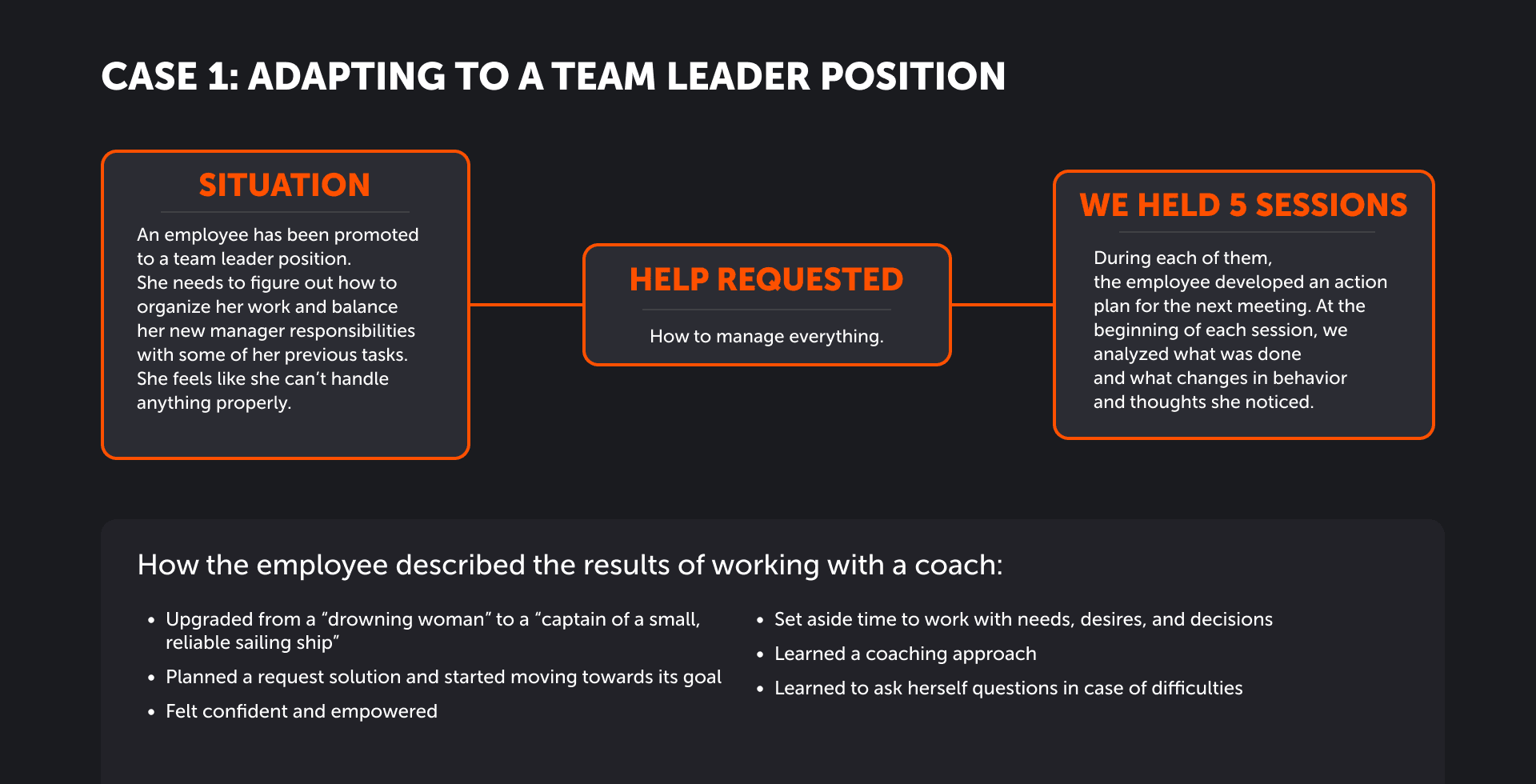
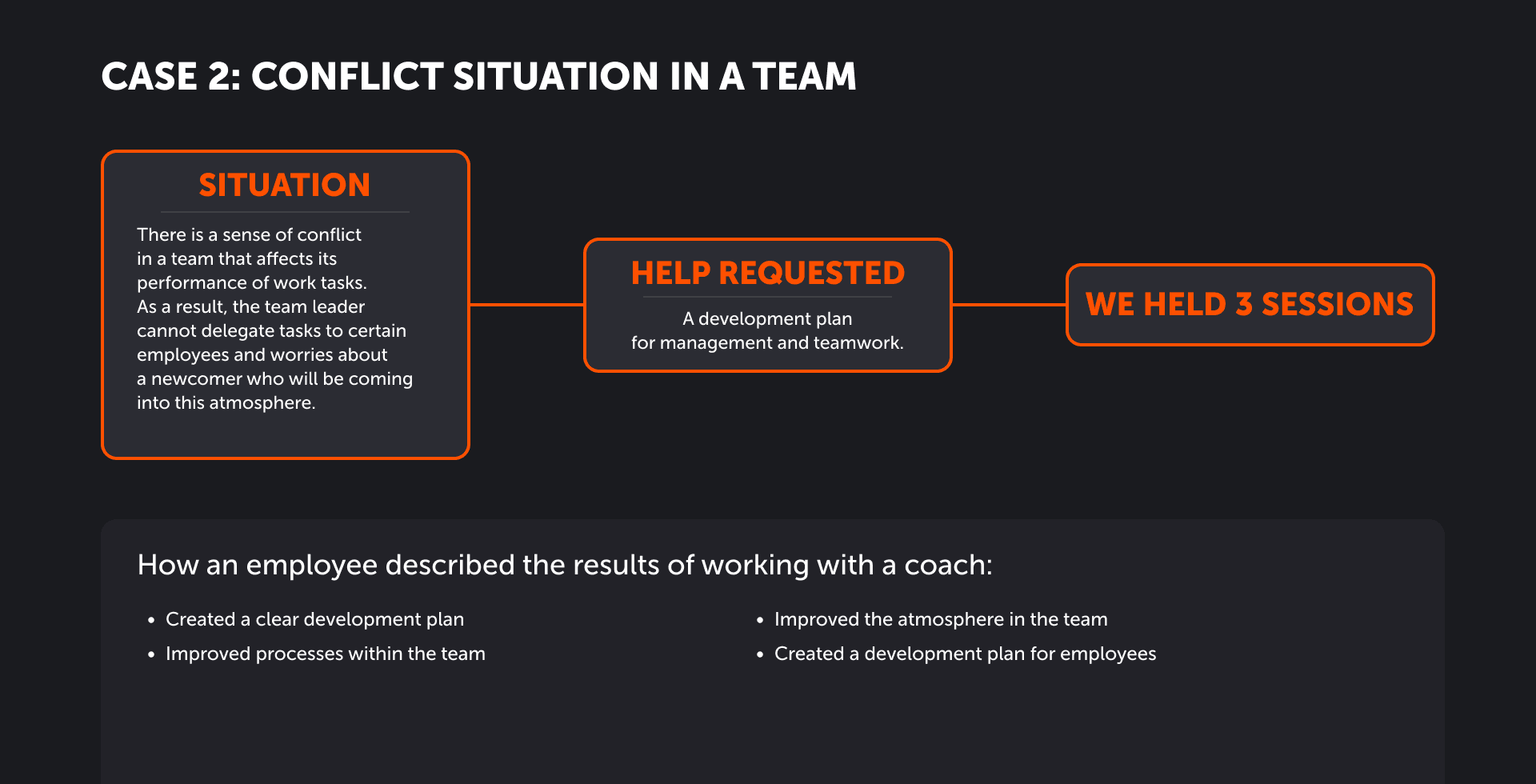
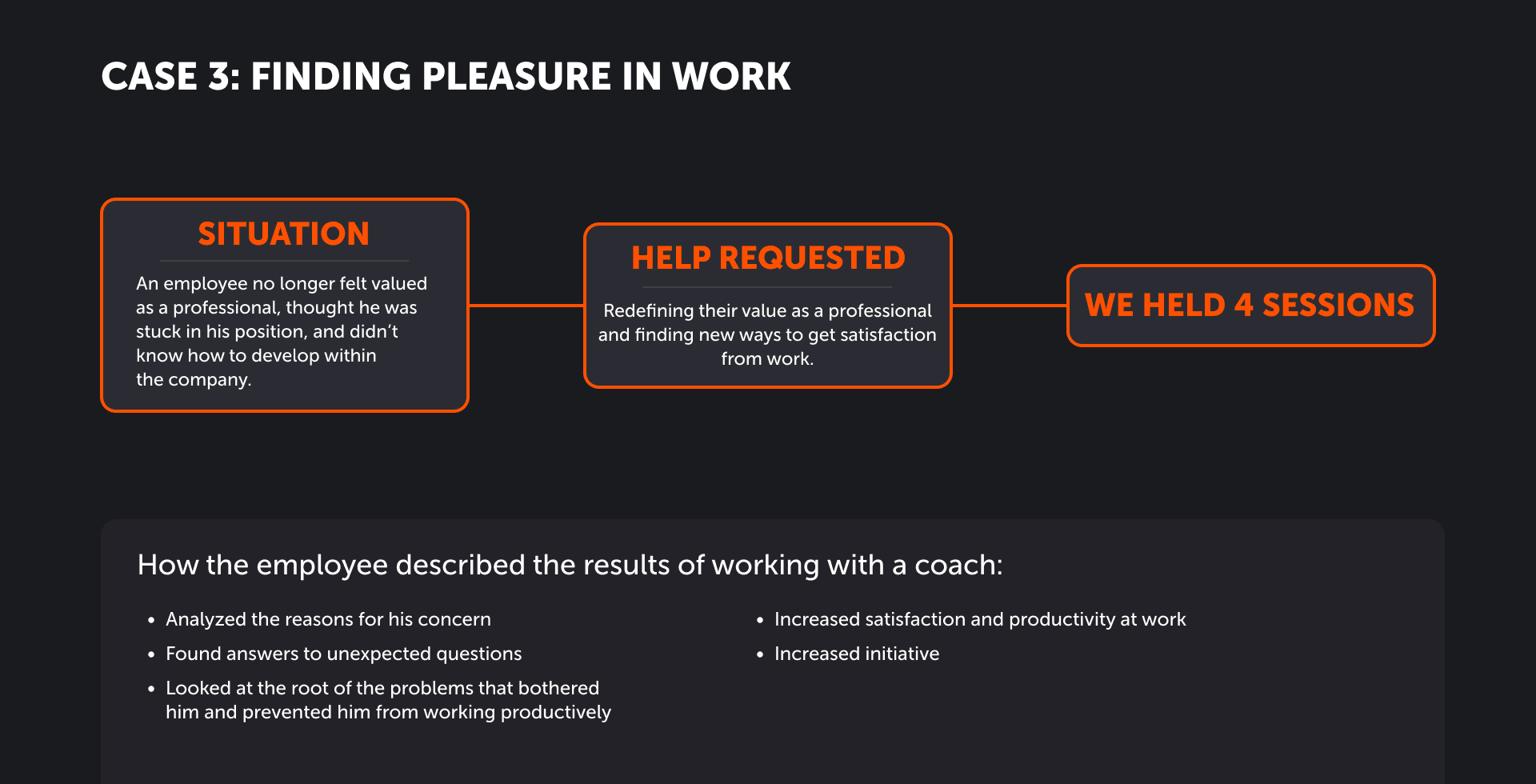
Our experience in implementing coaching
We decided to add coaching as a new tool for improving the company’s efficiency by working with leaders and developing their competencies.
We have divided the process of implementing coaching into the following steps:
- Preparation: studying the experiences of other companies and developing the principles of working with a coach in our company
- Developing an approach to measuring coaching effectiveness
- Choosing coaches
- Testing the project with a small group
- Scaling up coaching to other leaders
- Scaling up coaching to all company employees
Step 1: Preparation for coaching implementation: studying the experience of other companies and developing the principles of working with a coach
At this step, we held a series of meetings with external and internal coaches from other companies. They shared their experience, best practices, materials, and useful contacts with us. We also analyzed ICF research on the benefits of implementing coaching.
Based on the ICF standards and the experience of other companies, we have created the principles of working with a coach.
Privacy. A coach guarantees an employee confidentiality of information exchanged during the session. At the same time, a coach identifies the main requests, which we use during additional training.
Employee’s desires. Employees make their own decisions about working with a coach. The company doesn’t impose interaction with a coach on employees.
Duration of work. A coach conducts 4 to 8 sessions with the employee during working hours.
Certified coaches. A coach working with employees must be a professional who has received ICF certification (ACC level or higher) - the levels of certification will explain in more detail below.
Step 2: Developing an approach to measuring coaching effectiveness
We have developed our approach of measuring the effectiveness of coaching, which consists of the following questions.
For team leaders:
-
We asked the team leaders to conduct a self-assessment BEFORE and AFTER working with a coach. Our questions were based on the management competencies developed in the company.
-
After the team leaders completed their work with a coach, we asked their managers to fill out a questionnaire and indicate whether they noticed any changes in the team leaders’ work, and if so, what they were.
For team leaders and top-level managers:
We asked them to indicate what results they had achieved while working with a coach, offering possible answers in advance:
- I realized something important
- I made considerable progress on my request
- Work efficiency was increased
- Work satisfaction was increased
- I discovered new energy
- I found new opportunities, growth areas, and prospects
- I outlined a plan of action
We asked employees to rate the effectiveness of their interactions with a coach on a five-point scale with the following questions:
- Coaching was worth the investment of my time
- I am satisfied with the results of working with a coach
- I would recommend working with a coach to my colleagues
We asked to evaluate the coach’s professionalism because it was important to us that all sessions were conducted according to the standards of the International Coaching Federation (the questions were based on the ICF competencies), according to the following criteria:
- The coach explained what coaching is, described the principles of confidentiality of information, and the responsibility of both parties
- The coach created a safe environment that allowed me to express myself freely
- The coach was focused, observant, empathetic, and responsive
- The coach noted and explored emotions, energy changes, non-verbal cues, and other behaviors
Step 3: Choosing coaches - levels of professional coaches
Next, we started choosing coaches. There are the following professional coaching certifications developed by the ICF: ACC (Associate Certified Coach), PCC (Professional Certified Coach), and MCC (Mastered Certified Coach). To obtain each of these certifications, a coach needs to meet several criteria.
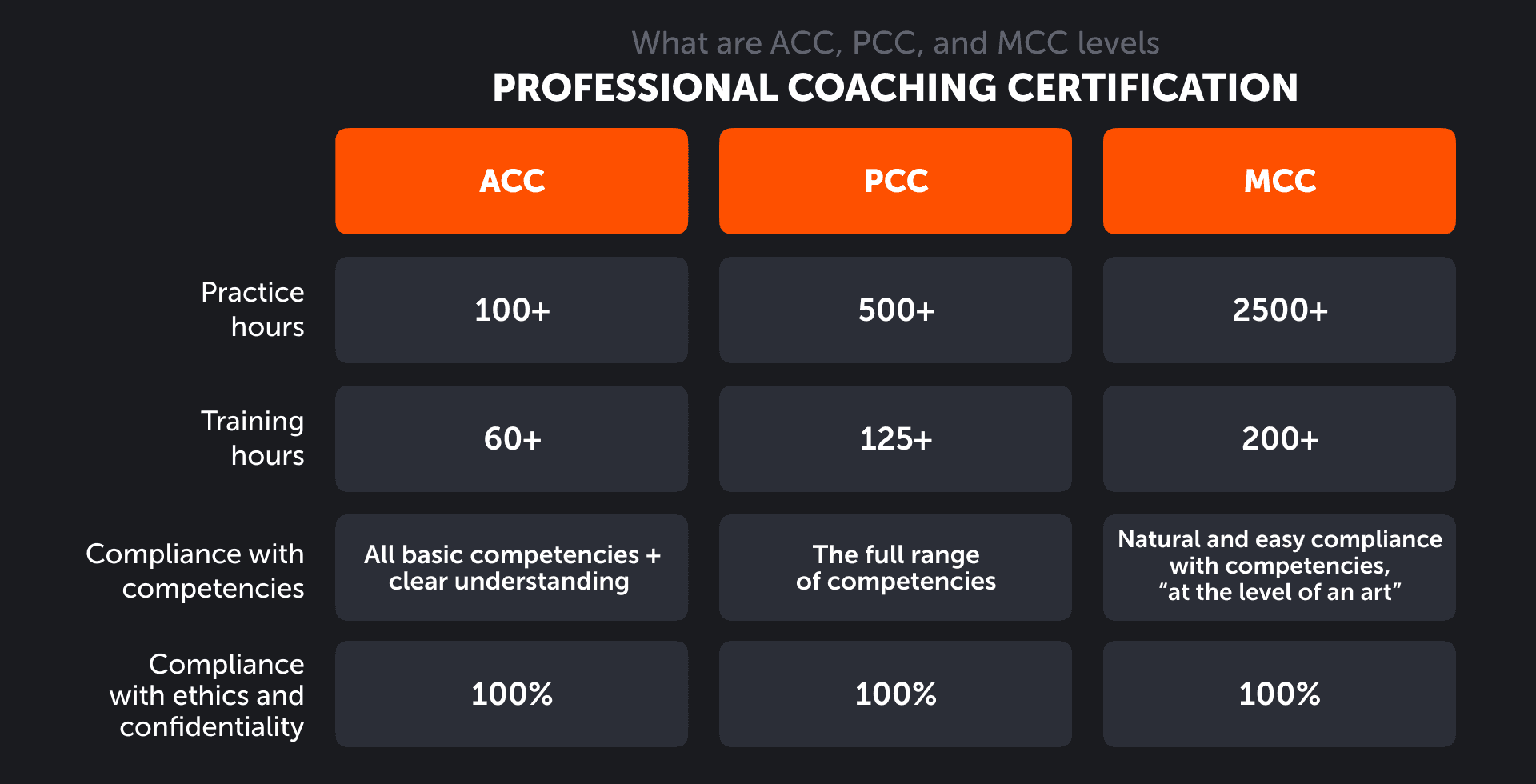
The practice hours that a coach needs to have to get certified are from direct experience with people. To reach the ACC level, you need to conduct at least 100 coaching sessions.
The training hours stand for special education at an accredited ICF school. Coach training should also include sessions with a mentor.
Compliance with competencies, ethics, and confidentiality is determined by a special assessment according to ICF standards. To get any of the above certifications, a coach needs to give a recording of their session to the assessors, who will make sure that the competencies are performed at the required level. After that, a coach passes an exam to test knowledge of the competencies and the code of ethics.
I became a coach for the company’s team leaders after receiving the ACC ICF certification. For the department managers, we decided to find an external coach who would meet the following criteria:
- ICF member at least the PCC level
- More than 1000 hours of practice with clients
- Experience working with companies, managers, and top managers
We chose a coach who met all our needs, and we have been successfully working with her for almost three years now :)
Step 4: Testing the project with a small group
We implemented coaching iteratively, so the next step was to perform testing. We needed to understand that the project was worth implementing in the company.
We offered coaching to 13 managers:
- Team leaders who had recently moved into this position
- Top-level managers who were currently in the active phase of solving professional challenges
- Key stakeholders so that they understand how coaching works
The testing period lasted three months. After analyzing the results, we concluded that everything went well: employees received answers to their queries, and many of them improved their self-esteem.
Since the results of the testing period met our expectations, we decided to extend coaching as a development tool to all managers at the company.
Step 5: Implementation of coaching as a tool for other managers
During the test period, we realized the benefits that our managers could gain. Therefore, we have:
- Integrated coaching into the adaptation program for new managerial positions
- Developed the following materials to introduce coaching:
Code of ethics and competencies of a coach according to ICF standards. It was important for us to show that coaching is a trustworthy approach that works according to clear standards.
Guidelines on how to prepare to work with a coach. This document explains how an employee can formulate key requests for a coach and how meetings will go.
After this, we informed all managers at the company about this new development tool. Each manager could register for a coaching session and recommend working with a coach to employees in their team.
Step 6: Scaling up coaching to all company employees
Two years after the project was launched, we began to scale up coaching to all employees who had been with the company for more than three years. Coaching can help them to determine their career development vector, improve competencies, reduce anxiety, effectively plan their working hours, prevent emotional burnout, and increase personal effectiveness.
We will continue to promote coaching among the company’s employees by showing the successful cases of our colleagues.
This step is currently being implemented, so I will explain it another time :)
How we raised the level of trust in coaching
When launching the project, we faced the following challenges.
Managers had a low level of trust in business coaching. They did not consider it a tool for development and efficiency improvement.
To raise awareness about coaching, we held a webinar about this it and debunked the main myths, for example:
- A coach will give me advice
- A coach will inspire me with his words
- Any person can conduct coaching sessions
- I don't need a coach, I can handle everything on my own
Many employees didn’t understand what requests they could make to a coach and what results could be achieved. That’s why it wasn’t in high demand.
Together with HR BP, we reminded managers and team leaders that they had the opportunity to work with a coach, and explained how it would help them solve problems. We shared an infographic with the results of the project in the company and showed examples of requests that their colleagues had already made.
The three-year results: how coaching helps employees and businesses
Since the launch of the project, a coach has been working with:
- 27% of company executives
- 19% of team leaders
They rated the effectiveness of coaching highly, with an overall average score of 4.88/5.
In addition, they indicated that they had received the following results (there was an option to select multiple answers):
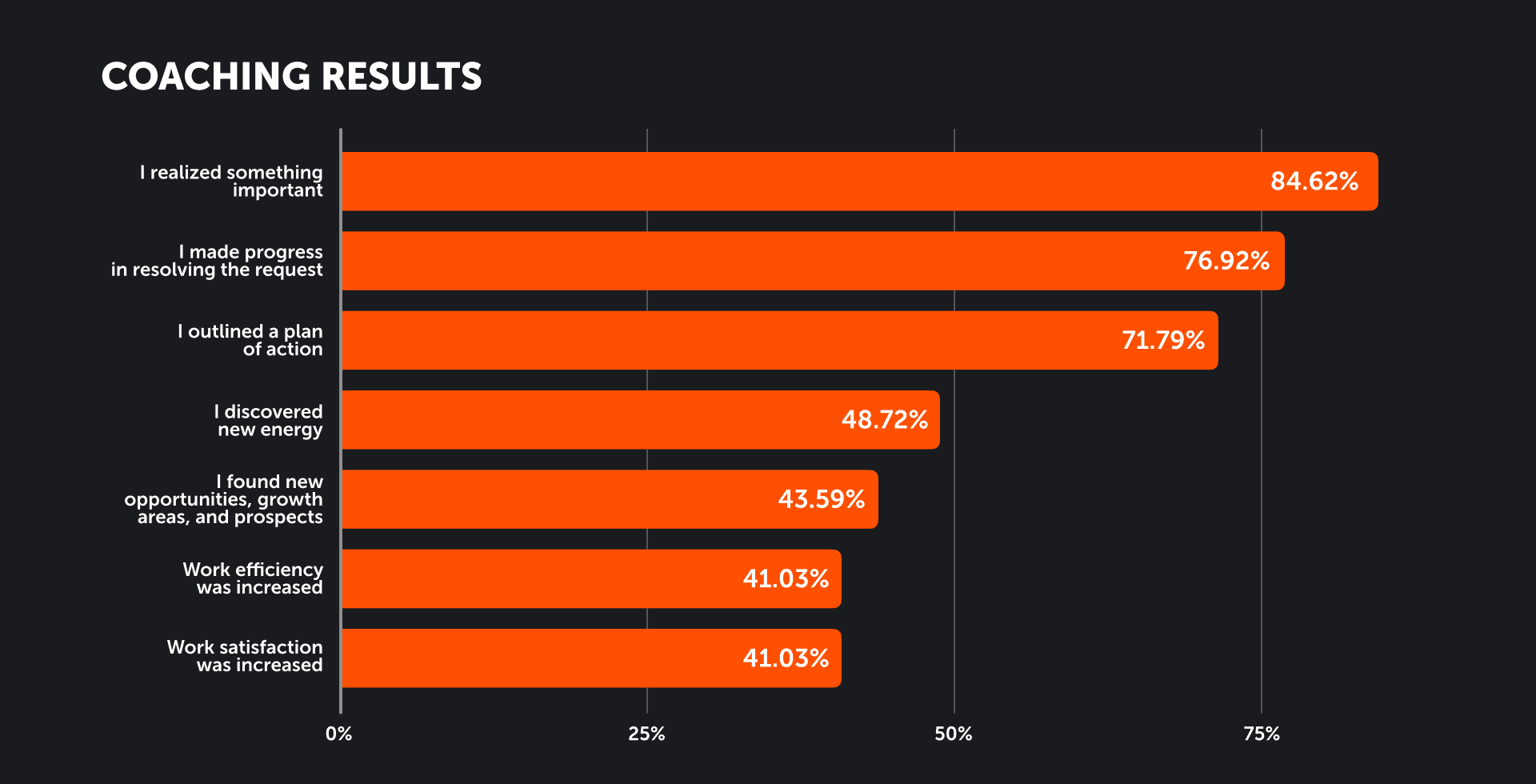
Employees began to recommend coaching to their colleagues. Those who had worked with a coach came back with new requests. People realized that coaching helps them find answers faster.
Managers analyze how a coach works with them, apply the coaching approach to themselves and their needs, and then implement it with their team. HR BPs are trained in the coaching approach and use it with employees and managers. We analyzed the most frequent requests and saw certain patterns. After that, we conducted several cycles of useful training for all managers based on the most popular requests.
Summary
In general, we saw that the project implementation helped our employees realize their problem areas, increased their self-confidence and motivation, as well as improved their internal state.
Coaching helps to grow a company and business by working with employees and developing their competencies: it increases the ability to make effective decisions, increases work involvement, and improves teamwork and relationships between colleagues. Moreover, working with a coach helps employees adapt to changes, uncertainty, and challenges. All these factors affect the way we achieve our business goals and our company moves forward.
Does your company have coaching? Do you consider it an effective tool? Share your thoughts in the comment section.



